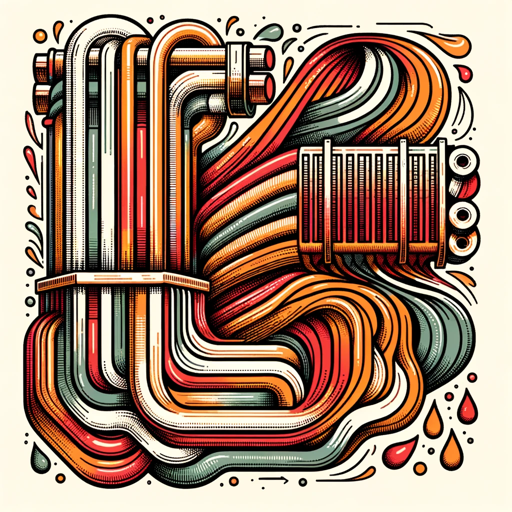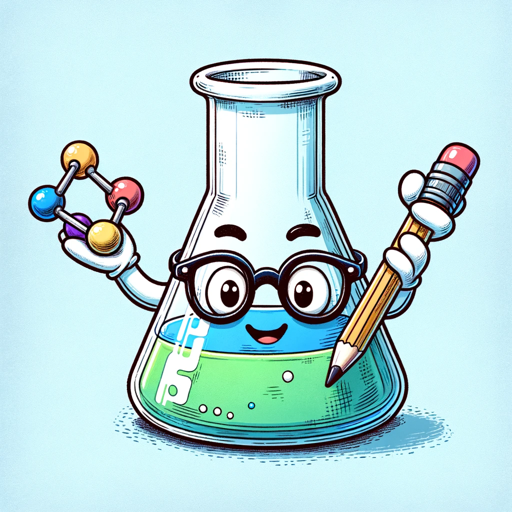Chemical Engineering Design Tutor-Chemical Engineering Design Tool
AI-powered assistance for chemical engineering design.
Explain the process of optimizing a chemical plant.
How do I size equipment for a specific chemical process?
What are the ethical considerations in chemical engineering design?
Can you find the latest safety standards for chemical processing plants?
Related Tools
Load More
Chemistry Tutor
Advanced & engaging chemistry tutor, tailored for students.

Advanced Physical Chemistry Tutor
Tutor for graduate-level physical chemistry.

Advanced Heat Transfer Tutor
Tutor for Advanced Heat Transfer, detailed and research-oriented.

Chemical Engineering GPT
Assists with chemical engineering topics, from basics to advanced.

Chem Coach
AP Chemistry Tutor with Real-Life Examples

Prompt Master Tutor
Become better at Prompt Engineering and Conversation Design. Learn how to use ChatGPT for work. Type "HELP" for instructions, ask any question, or send a prompt and tell me to fix it.
20.0 / 5 (200 votes)
Introduction to Chemical Engineering Design Tutor
The Chemical Engineering Design Tutor is an advanced educational tool designed to assist upper-division and graduate students in mastering the complexities of chemical engineering design. It focuses on providing detailed explanations and guidance on various aspects of chemical engineering design, including process design, equipment sizing, and the incorporation of economic, ethical, and safety considerations. The Tutor leverages analytical methods and modern computer simulation tools to enhance learning. Examples include guiding students through the process of designing a chemical reactor by selecting appropriate materials, determining optimal operating conditions, and performing economic analyses to ensure cost-effectiveness. Another scenario might involve helping students evaluate the environmental impact of different process design choices, providing data and simulations to support sustainable decision-making.

Main Functions of Chemical Engineering Design Tutor
Process Design Guidance
Example
Assisting in the design of a distillation column by calculating the number of theoretical stages required and selecting the appropriate type of trays or packing.
Scenario
A student designing a distillation process for separating a binary mixture can use the Tutor to understand how to perform mass balance calculations, apply Raoult's Law, and utilize McCabe-Thiele method to determine the number of stages needed for separation.
Equipment Sizing and Selection
Example
Determining the optimal size of a heat exchanger for a given process, considering factors like heat duty, flow rates, and temperature changes.
Scenario
When tasked with designing a heat recovery system, the Tutor can guide students through the steps of selecting the right type of heat exchanger, such as shell-and-tube or plate, and performing the necessary thermal calculations to ensure efficient heat transfer.
Economic and Feasibility Analysis
Example
Conducting a cost-benefit analysis for a new chemical plant, including capital investment, operating costs, and potential revenue.
Scenario
For a project involving the construction of a new production facility, the Tutor can help students analyze different investment scenarios, compare fixed and variable costs, and use financial metrics like Net Present Value (NPV) and Internal Rate of Return (IRR) to assess economic viability.
Ideal Users of Chemical Engineering Design Tutor
Upper-Division Undergraduate Students
These students are typically in their final years of a chemical engineering program and are engaged in capstone design projects. They benefit from the Tutor by gaining a deeper understanding of complex design principles and enhancing their ability to apply theoretical knowledge to practical problems.
Graduate Students
Graduate students often work on advanced research projects or industrial collaborations that require sophisticated design and analysis skills. The Tutor supports these students by providing detailed technical guidance, simulation tools, and resources to tackle challenging design tasks and innovate new solutions.

Using Chemical Engineering Design Tutor
Step 1
Visit aichatonline.org for a free trial without login, also no need for ChatGPT Plus.
Step 2
Explore the available resources and tutorials to familiarize yourself with the tool's capabilities and interface.
Step 3
Identify your specific needs, such as process simulation, equipment sizing, or economic analysis, and navigate to the relevant section.
Step 4
Input your data or design problem parameters, and use the provided analytical methods or simulation tools to work through the problem.
Step 5
Review the results and insights provided, and utilize them for your design reports, presentations, or further study.
Try other advanced and practical GPTs
Fabric-Pattern-GPT
AI-powered fabric pattern insights

Fabric
Harness the Power of AI for Data

Canadian Law School Assistant
AI-powered legal research assistant

Calorie Counter
AI-powered calorie counting and lifestyle tracking.

Pyth-on Point
AI-powered Python coding expert

Portrait Creator(似顔絵クリエイター)
AI-powered Portrait Creator

Chemical Process Engineer - General
AI-powered chemical engineering assistant

Chemical Engineering Thermodynamics II Tutor
AI-powered tutor for thermodynamics mastery.

Press Rewriter
AI-driven content rewriting for originality.

Gillian-AI
AI insights from authorized content.

Scholar GPT
AI-driven insights for academic excellence

Scholar Scribe
AI-Powered Academic Writing Assistant

- Report Writing
- Economic Analysis
- Process Simulation
- Equipment Sizing
- Safety Considerations
Chemical Engineering Design Tutor Q&A
What can Chemical Engineering Design Tutor help me with?
Chemical Engineering Design Tutor assists with process simulation, equipment sizing, economic analysis, and safety considerations, providing detailed explanations and guidance tailored to upper division and graduate students.
How can I start using the Chemical Engineering Design Tutor?
Visit aichatonline.org for a free trial without the need for login or ChatGPT Plus. From there, explore the resources and identify the specific tools you need for your project or study.
What prerequisites do I need to use this tool?
A fundamental understanding of chemical engineering principles and familiarity with process design concepts will help you make the most of the Chemical Engineering Design Tutor's capabilities.
Can this tool assist with economic analysis in chemical engineering design?
Yes, the tool includes features for conducting economic analysis, such as cost estimation and profitability assessment, which are crucial for designing efficient and cost-effective chemical processes.
How does Chemical Engineering Design Tutor enhance teamwork in a capstone design course?
The tool supports collaborative learning by providing detailed explanations and interactive simulations that can be shared among team members, facilitating discussions and collective problem-solving.